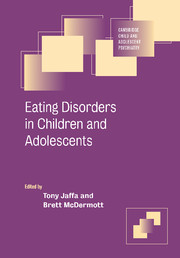Book contents
- Frontmatter
- Contents
- List of Contributors
- Part I Introduction
- Part II Scientific underpinnings
- Part III Abnormal states
- 9 Anorexia nervosa in children and adolescents
- 10 Eating disorders in boys
- 11 Bingeing and bulimia nervosa in children and adolescents
- 12 Selective eating and other atypical eating problems
- 13 Comorbid anxiety and depression and the role of trauma in children and adolescents with eating disorders
- 14 Eating disorders in children with disabilities and chronic illness
- 15 Childhood obesity
- Part IV Evidence-based care
- Part V Public health perspectives
- Index
- References
13 - Comorbid anxiety and depression and the role of trauma in children and adolescents with eating disorders
from Part III - Abnormal states
Published online by Cambridge University Press: 02 December 2009
- Frontmatter
- Contents
- List of Contributors
- Part I Introduction
- Part II Scientific underpinnings
- Part III Abnormal states
- 9 Anorexia nervosa in children and adolescents
- 10 Eating disorders in boys
- 11 Bingeing and bulimia nervosa in children and adolescents
- 12 Selective eating and other atypical eating problems
- 13 Comorbid anxiety and depression and the role of trauma in children and adolescents with eating disorders
- 14 Eating disorders in children with disabilities and chronic illness
- 15 Childhood obesity
- Part IV Evidence-based care
- Part V Public health perspectives
- Index
- References
Summary
Introduction
In many cases it is not the eating disorder (ED) symptom or sign per se that brings the child or adolescent with an ED into treatment, but instead it is a related yet serious comorbid problem or condition which merits medical and/or psychiatric attention, e.g. suicide attempt, depression and/or anxiety. Even when the ED is established at presentation the recognition of comorbid anxious and depressive symptoms in children and adolescents is of paramount importance for successful treatment and outcome. The presence or absence of comorbidity may affect long-term prognosis.
Anxiety
In a study of 2525 Australian teenagers Patton et al. (1997) found psychiatric comorbidity to be the clearest factor associated with extreme dieting with 62% of extreme dieters reporting high levels of both anxiety and depression.
Bulik et al. (1997) looked at the prevalence and age of onset of anxiety disorders in 68 women with anorexia nervosa (AN), 116 women with bulimia nervosa (BN), 56 women with major depression (MD) with no ED and 98 randomly selected controls (RC). Comorbid anxiety disorders were common in all three patient groups (AN, 60%; BN, 57%; MD, 48%). In those cases with comorbid anxiety, 90% of AN women, 94% of BN women and 71% of MD women had anxiety disorders preceding the current primary condition (P ≤ 0.01). It is of note, however, that panic disorder tended to develop after the onset of AN, BN or MD rather than preceding these conditions.
Keywords
- Type
- Chapter
- Information
- Eating Disorders in Children and Adolescents , pp. 158 - 168Publisher: Cambridge University PressPrint publication year: 2006
References
- 6
- Cited by

